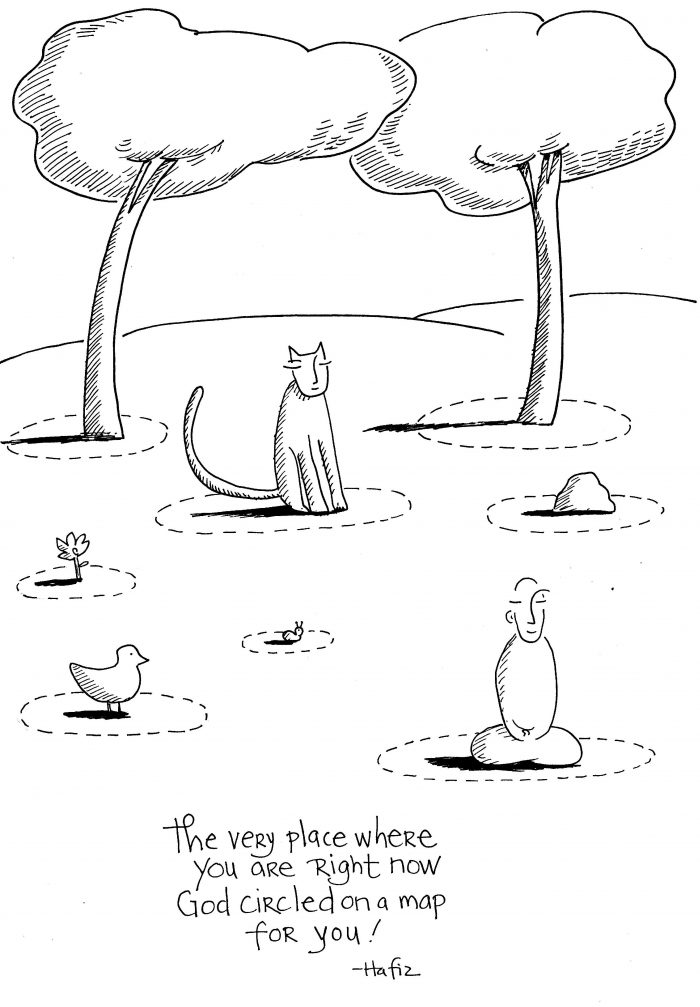Recently, a reader sent a thoughtful question:
“What is the difference between wisely stepping out of one’s comfort zone into more openness to life and consciousness vs. a lack of healthy and loving personal boundaries.”
Given the current state of the world, this is a timely question.
Yes, it can be hard to see that edge. Often it’s more difficult to maintain healthy, peaceful, and strong personal boundaries than it is to be vulnerable enough to connect with others.
There’s an old yogi story that will help us dive deeper into this topic.
Once upon a yogi time, the wandering sage Narayana was seated in meditation at the edge of a small village. Upon opening his eyes, returning to everyday awareness, he found himself face-to-face with a large cobra.
“Oh, Narayana, please instruct me in the practice of yoga,” said the snake.
Delighted by the request, the guru began explaining the principle of ahimsa.
“Ahimsa is the nonviolent attitude of the yogi,” he taught. “It is a way of relating to life with openness, curiosity, and loving awareness. By adopting the attitude of ahimsa, you will be able to welcome all that arises and engage with your life without creating pain or suffering.” Especially for a cobra, whose very body was designed to strike out with violence and venom, ahimsa is a foundation of the spiritual life.
Thanking Narayana, the snake disappeared into the dense undergrowth.
Never resting more than three days in any single location, the sage continued his pilgrimage. After a year, Narayana, again, found himself approaching the same village.
“I wonder how my cobra-disciple is faring and how his spiritual practice is developing,” he thought to himself.
The sage heard a groan rising from behind a nearby tree.
Narayana discovered his disciple cowering in the dirt. The cobra’s body was bruised and battered, his sharp teeth were shattered, and his left eye was swollen shut.
“What has happened to you?” the sage exclaimed.
“Oh, guru-ji,” the cobra lisped through broken teeth, “You would have been so proud of me. I took up the practice of ahimsa with great dedication. When the young boys of the village threw stones at me, I smiled. They were surprised by my new gentle demeanor and came closer carrying sticks.
But, I continued to smile and welcome them. They struck me and beat me; they kicked me and tied me in knots; they broke my teeth and bruised my eye. But, I didn’t bite or strike back.”
“Oh, my disciple,” Narayana shook his head. “I told you not to bite. I didn’t say you shouldn’t hiss.”
You have to hiss. You must protect yourself from forces that are harmful. What makes the difference between a wise stance and a deluded-defensive one is in how you protect yourself and the attitude with which you protect.
Because, you have to take a stance—you have no choice. On the Earth plane, boundaries and distinctions are part of the game. To understand the difference between a loving and defended stance:
>> In the defended stance, you set boundaries to protect yourself and those you love from life.
>> In the wise and loving stance, you set up boundaries to protect yourself and those you love for life.
You have a choice: protecting from life or protecting for life.
The defended stance will pit you against life. Whatever arises on the other side of the boundary is unknown, a threat to your very existence, worthy of destruction.
The wise and loving stance places you in the midst of life. It does not separate you from life. It preserves and even deepens your sense of interdependence. When you are protected by wise and loving boundaries, you maintain your connection with those who are “on the other side.” Their presence and perspectives will no longer generate fear, but instead provoke curiosity and care.
But, this doesn’t mean that you smile if the stones start flying. If others approach with sticks—you still must hiss.
Being for life includes being for your body, mind, emotions, and circumstances. You can draw clear boundaries that honor your integrity. And if it is required, flash your claws. And yet you can do so without anger and without viewing the other as the enemy.
Wise boundaries allow you to see the suffering behind their violence.
You will be able to see how fear and inner fragmentation are so very often expressed in mental, verbal, and physical violence. You will be able to see how their inability to meet and understand their own suffering ends up fueling a fear-based, defensive stance toward the whole world.
You will be able to see how easy it would be to shift from hissing to biting. But you won’t follow their lead. You will refuse to meet their defensive, suffering-fueled actions with your own.
Seeing this with clarity and without blame can allow you to strengthen—with love—the boundaries that will preserve your values and honor the deep interdependence of life.
Your capacity to establish wise boundaries—in the midst of conflict, tensions (and even family holidays)—is supported by two things:
- Establishing a stable foundation of meditative awareness.
- Becoming a devoted student of how defensiveness arises in your body.
You can establish meditative awareness as the default mode of your perception, through daily spiritual practice.
In this, you can learn how to reside in loving awareness; how to witness thoughts, emotions, and sensations that rise and fall. This capacity makes it possible for you to study the signature patterns that arise when you shift from wisdom to defensiveness.
As you become more aware of your patterns of defensiveness, you can discover something marvelous. The patterns of defensiveness and reactivity are amazingly redundant.
The situations that trigger the defensiveness will change—but the patterns don’t. This is particularly true at the bodily level of sensations. And this is great news.
The somatic signature of your reactivity repeats itself with virtually no variation.
It’s an automated response that flows through a well-grooved neural pathway and arises as a signature pattern of sensations.
Whenever this pattern arises, reactivity is trying to become your default mode of operating. Don’t let it. Breathe. Be mindful. Return to meditative presence. Having reestablished your meditative seat, draw the boundaries that allow you to serve, create, and enrich life.
And by life, I mean your life, and the lives of all the other beings you encounter on your path.
~






Read 3 comments and reply